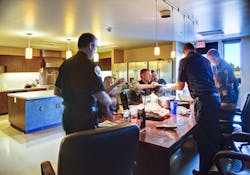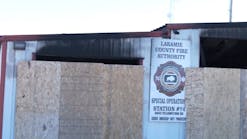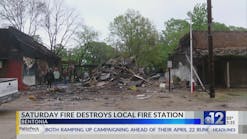After years of working with fire departments and districts throughout the northwest region, it has become apparent that the kitchen plays a critical role in the daily routine of the station staff. The design and layout of the kitchen is vital to that role. It not only serves as the means to store and prepare food but can also be a central hub and gathering space.
There are several aspects that should be considered to maximize the functionality of a station’s kitchen. Whether it is a separate room or part of a great room, open to the dining area and day room, it is important to consider: layout and function, appliances, finishes and durability, lighting, accessibility, HVAC and occupancy.
Layout and function
Depending on the culture of the department there may be a desire to have an open plan, providing visual and physical connection between the kitchen, dining room, day room, and even other adjacent spaces. We regularly see a desire to design this common area as a hearth that is an inviting, comfortable space for station staff to mingle and unwind. We find this provides an opportunity to open up the inside of the station and encourages further camaraderie between the firefighters.
Alternately, there is sometimes a desire that the kitchen and dining room be isolated from other spaces, limiting the transmission of sound throughout the rest of the station, and curtailing possible distractions. Often, if the kitchen, dayroom and dining room are connected, other spaces are provided for the crew to utilize for study, private conversations or phone calls.
If sound is a concern, but there is a desire for a more open plan, the selection of materials, including carpet, acoustic ceilings, and even acoustic wall panels help mitigate these issues, while satisfying the cultural priorities of the department.
Appliances
Appliances found in a fire station are generally the same type as within any private kitchen. To provide an increased level of durability, departments often select commercial-grade appliances, or heavy-duty residential appliances. Typical appliances found in these kitchens include a six-burner range, double-wall oven, dishwasher, microwaves and refrigerators.
Appliances can constitute approximately 15 percent of the electrical usage of a fire station, making it advisable to select high-efficiency appliances. The easiest way to ensure energy efficiency is to select models that meet EnergyStar requirements. In recent years, the cost of high-end, energy-efficient appliances has dropped to be more or less on par with their standard efficiency counterparts. Modern appliances are generally very dependable, and when properly maintained, have a long life. Selecting efficient appliances, even at a slight premium, will have an immediate positive impact on the operating costs of the station, and can pay for itself in a matter of months with reduced energy bills.
In addition to interior appliances, grills or barbecues are regularly installed at patio or deck areas. Protecting exterior appliances from the elements under a canopy mounted directly to the building, or even a separate structure, built as an outdoor kitchen, extend the life of the appliance, and limits required maintenance.
We recommend grills be connected to natural gas lines, where available, and included in the tap-out system. When installed as part of the tap-out system, natural gas and electric appliances can be automatically shut off when a call is received. A manual override enables the crew to reset the device, and turn on the gas upon return, reducing chances of a fire starting in the station while the crew are out, and (less critically) avoiding coming back to a burnt meal.
Finishes and durability
Just as the culture can vary dramatically from one department to another, so can the finishes.
The culture, and even the surrounding community, will have an impact on the desired aesthetic, and materials selected. Floor finish options vary from stained or polished concrete, to luxury vinyl or porcelain tile. The benefit of lower maintenance or replacement costs of a concrete finish may be outweighed by the more predictable finish quality of a tile. When designing kitchens within a large dayroom, a more durable finish may be selected to unify the space, with an area rug or carpet incorporated into the design to provide delineation of space and promote a relaxing atmosphere. Of critical importance when selecting flooring is ensuring that it is slip resistant, allowing the firefighters to safely exit the building during a call.
Cabinets within the kitchen are typically laid out with defined "shift-pantries," designed to provide large amounts of storage for meal preparation, and delineated between shifts to allow each crew to define their own meal plan, and avoid conflict between shifts. In addition to shift pantries, a department might choose to provide individual lockers for each firefighter to store their personnel food items. Cabinets are often constructed with a hardwood core, instead of particleboard, to withstand the heavy use. Cabinet finishes can vary from plastic laminate, to wood veneer, or even stainless steel. As with flooring, each finish has benefits that must be weighed against the others.
Even more than the cabinets, countertops need to withstand high intensity use, and we often recommend a solid surface or granite, though some departments will go as far as to request concrete counters. A large island can serve as an informal meeting area, bringing the station together between meals.
Typically a tile or solid surface backsplash is installed from the top of counter to the underside of the upper cabinets. The backsplash is easy to clean and wipe down, and provides years of maintenance-free use.
Lighting
The fire station kitchen offers some of the best opportunities to bring natural light into the living quarters of the station. Whenever possible we recommend that the kitchen be connected to an outdoor seating area, accessible through a large storefront window system to aid in bringing light into the space.
Accent lighting and pendant fixtures are often placed above the island, providing a better lighting quality on the main work surface, and taking advantage of an opportunity to marry form to function.
Accessibility considerations
It may come as a surprise to some, but fire stations are federally mandated to meet all applicable Americans with Disabilities (ADA) standards. This ensures that crew members on light or desk duty are able to work in and navigate the station.
ADA standards with particular implications to the kitchen include counter heights, reach-range, and turning spaces. Standard kitchen counter heights are 36 inches above finish floor, while islands may be provided at 42 inches bar height. To ensure compliance with ADA, the sink and adjacent counter must be provided at 34 inches high. To ensure adequate reach-range, the cabinet under the sink must be able to be modified to allow forward access, which typically can be accomplished by removing the doors, and kick-stop under the counter. The minimum required turning circle for any U-shaped kitchen is a five-foot clear diameter, while a galley kitchen can be reduced to a minimum 40-inch clear floor space.
HVAC
Heating, ventilation and air conditioning are often functional requirements that are overlooked design opportunities that can have major impacts to enhance occupants’ comfort. Typically exhaust from kitchen and dining areas are dedicated to separate exhaust duct work that discharges heat and odors directly outside rather than being collected through the common building return air system. Stovetops or range hood requirements can vary based on use, building code, and authority having jurisdiction (AHJ). Frequently, Type 1 hoods with a dedicated fire suppression system are required for the stovetop, but are recommended regardless of how the local AHJ interprets and enforces the building code. Type 1 hoods are designed to capture smoke and grease and the routing of the duct needs to be carefully selected to allow for periodic cleaning and removal of accumulated grease. It should be noted that Type 1 hoods require periodic maintenance and inspection, which is an expense that should be included in the annual budget.
Occupancy
Fire stations are a building type with mixed occupancies based on use (as delineated by the International Building Code). Typically occupancies are classified as S-2, B, R-2, and (less frequently) A-3 depending on the program specifics.
The living quarters, particularly the bunk rooms and the kitchen, dining, and dayroom areas, are generally classified as an R-2 occupancy. Depending on the building codes and in your area, a one-hour fire resistant separation may be required between the R-2 occupancy and other building uses. Your team should confirm this requirement early in the design process to ensure that its implications are considered and understood, providing the flow, flexibility and layout that meets expectations.
JEFF HUMPHREYS is the director of architecture and leader of Mackenzie’s public projects team. Humphreys has more than 20 years of architectural experience and specializes in public safety and emergency response facilities, serving as project lead on nearly all of Mackenzie’s public safety projects over the past decade. He is a board member for the Oregon Fire Chief Foundation and takes an active role in the design community, and regularly presents at fire and police design conferences.
KIM DOYLE is the project manager and senior interior designer for Mackenzie and has been working in the field of interior design and architecture for over 17 years. Doyle specializes in designing and managing public facilities, including public safety and emergency response, Department of Defense, medical office and educational facilities. She is a returning member of the Police Unity Tour and volunteers with Behind the Badge Foundation and The Soup Ladies.






